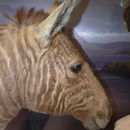Biology
provided by Arkive
In common with the plains zebra it is likely that quaggas were found in groups, known as harems, consisting of a number of adult females and led by a dominant male (2). Both males and females leave their natal group when they reach sexual maturity; the composition of adult harems is relatively stable over time with strong social bonds between individuals (6). Foals were born year-round although there appeared to be a peak season in early summer, from December to January (2).
As with other equid species, the quagga diet consisted primarily of grasses. Herds tended to migrate to longer grass pastures during the day to feed, returning to areas of shorter grass at night where potential predators had less cover (2).
Conservation
provided by Arkive
A plan to 'retrieve' the quagga is now being carried out in South Africa by the Quagga Project (5). Recent genetic studies on several museum samples revealed that the quagga was indeed a subspecies of the plains zebra and not a distinct species (4). This added fresh hope to the idea that selective breeding of particular plains zebras would lead eventually to an animal resembling the long-lost quagga in appearance. Under the guidance of Reinhold Rau, the project began in earnest in 1987 (5), and by 2008, over 25 third generation foals had been successfully reared, with some of these having coat patterns beginning to approximate those of some of the museum quaggas (7). There has been some controversy about this project, for example, some authorities criticize the project for appearing to demonstrate that it is possible to bring an animal back from extinction. However, proponents believe that a high profile project, which involves the return of these zebras to the grasslands where quaggas once roamed, may help to raise awareness of the importance of the fragile Karoo grassland of Southern Africa (8).
Description
provided by Arkive
The quagga roamed the plains of South Africa until the late 19th Century when it became extinct. Once considered a separate species (1), the quagga is now generally accepted as a subspecies of the plain's zebra (3) (4). However, with their dark stripes on the head and neck merging into brown coloured hindquarters (2) and pale legs devoid of stripes (5), quaggas did look quite distinctive compared to the zebras that we recognise today (2). As with other zebra species, the patterns of the stripes were unique to each individual (2).
Habitat
provided by Arkive
Previously found in the arid and temperate grasslands of South Africa (2).
Range
provided by Arkive
Quaggas were found in the Karoo and southern Free State of South Africa. The date of the disappearance of the last wild animal is unknown but the final quagga died at the Artis Magistra Zoo in Amsterdam in 1883 (5).
Status
provided by Arkive
Classified as Extinct (EX) by the IUCN Red List 2007 (1).
Threats
provided by Arkive
South Africa became renowned for hunting in the 19th Century, and was known as a 'hunters paradise' (5). Many species, including the quagga, were persecuted for sport and to supply the leather trade with unusual hides (5). In addition, on the sparse, dry grasslands of the Karoo, farmers regarded the quagga as a serious competitor for grazing land with introduced sheep and cattle. During this time, the term 'quagga' in Afrikaans was used for all zebras, and this produced confusion; the uniqueness of this particular zebra was not fully recognised until it was too late (5).

